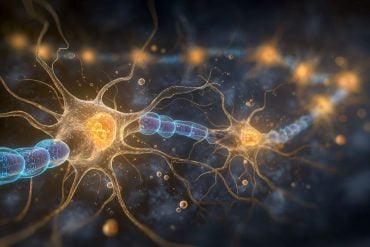Summary: A recent study links exposure to air pollutants during pregnancy and childhood with lasting changes in the brain’s white matter microstructure, affecting cognitive development through adolescence. The research, which followed over 4,000 participants, found that pollutants like PM2.5 and nitrogen oxides (NOx) were associated with developmental delays in white matter integrity.
These findings highlight the long-term impact of air pollution on neurodevelopment, underscoring the need for stricter regulations. Some pollutant effects diminished over time, while others persisted into adolescence.
Key Facts:
- Air pollutants PM2.5 and NOx are linked to white matter changes in children’s brains.
- The effects of exposure during pregnancy and childhood can persist into adolescence.
- Some impacts of pollution on brain development may lessen with age, but many remain long-term.
Source: ISGLOBAL
Exposure to certain pollutants, like fine particles (PM2.5) and nitrogen oxides (NOx), during pregnancy and childhood is associated with differences in the microstructure of the brain´s white matter, and some of these effects persist throughout adolescence.
These are the main conclusions of a study led by the Barcelona Institute for Global Health (ISGlobal), a centre supported by “la Caixa” Foundation.
The findings, published in Environmental Research, highlight the importance of addressing air pollution as a public health issue, particularly for pregnant women and children.
An increasing amount of evidence suggests that air pollution affects neurodevelopment in children. Recent studies using imaging techniques have looked at the impact of air pollutants on the brain’s white matter, which plays a crucial role in connecting different brain regions.
However, these studies were limited in that they only looked at one timepoint and did not follow the participants throughout childhood.
“Following participants throughout childhood and including two neuroimaging assessments for each child would shed new light on whether the effects of air pollution on white matter persist, attenuate, or worsen,” says ISGlobal researcher Mònica Guxens. And that is what she and her team did.
The study involved over 4,000 participants who had been followed since birth as part of the Generation R Study in Rotterdam, the Netherlands. The research team estimated the amount of exposure to 14 different air pollutants during pregnancy and childhood, based on where the families lived.
For 1,314 children, the researchers were able to use data from two brain scans – one performed around 10 years of age and another around 14 years of age – to examine changes in white matter microstructure.
Some effects persist, some diminish over time
The analysis found that exposure to certain pollutants, like fine particles (PM2.5) and nitrogen oxides (NOx), was linked to differences in the development of white matter in the brain.
Specifically, higher exposure to PM2.5 during pregnancy, and higher exposure to PM2.5, PM10, PM2.5-10, and NOx during childhood were associated with lower levels of a measure called fractional anisotropy, which measures how water molecules diffuse within the brain. In more mature brains, water flows more in one direction than in all directions, which gives higher values for this marker.
This association persisted throughout adolescence (i.e. it was also observed in the second scan), suggesting a long-term impact of air pollution on brain development. Every increase in exposure level to air pollution corresponded to more than a 5-month delay in the development of fractional anisotropy.
“We think that the lower fractional anisotropy is likely the result of changes in myelin, the protective sheath that forms around the nerves, rather than in the structure or packaging of the nerve fibers” says Michelle Kusters, ISGlobal researcher and first author of the study.
How air pollutants affect myelin is not fully understood, but could be linked to the entrance of small particles directly to the brain or to inflammatory mediators produced by the body when the particles enter the lungs. Together, this would lead to neuroinflammation, oxidative stress, and eventually neuronal death, as documented in animal studies.
The study also found that some pollutants were linked to changes in another measure of white matter, called mean diffusivity, which reflects the integrity of white matter, and which tends to decrease as the brain matures.
Higher exposure to pollutants like silicon in fine particles (PM2.5) during pregnancy was associated with initially higher mean diffusivity, which then decreased more rapidly as the children grew older. This indicates that some effects of air pollution may diminish over time.
Policy implications
Overall, the study suggests that air pollution exposure, both during pregnancy and early childhood, can have lasting effects on the brain’s white matter.
“Even if the size of the effects were small, this can have a meaningful impact on a population scale,” says Guxens.
Importantly, these findings were present in children exposed to PM2.5 and PM10 concentrations above the currently recommended maximum values by the WHO but below those currently recommended by the European Union.
“Our study provides support to the need for more stringent European guidelines on air pollution, which are expected to be approved soon by the European Parliament,” adds Guxens.
In a previous study, Guxens and her team showed that white matter microstructure can also be affected by early exposure to heat and cold, especially in children living in poorer neighbourhoods.
About this neurodevelopment and pollution research news
Author: Pau Rubio
Source: ISGLOBAL
Contact: Pau Rubio – ISGLOBAL
Image: The image is credited to Neuroscience News
Original Research: Open access.
“Residential ambient air pollution exposure and the development of white matter microstructure throughout adolescence” by Mònica Guxens et al. Environmental Research
Abstract
Residential ambient air pollution exposure and the development of white matter microstructure throughout adolescence
Background
Recent evidence suggests an association of air pollution exposure with brain development, but evidence on white matter microstructure in children is scarce. We investigated how air pollution exposure during pregnancy and childhood impacts longitudinal development of white matter microstructure throughout adolescence.
Methods
Our study population consisted of 4108 participants of Generation R, a large population-based birth cohort from Rotterdam, the Netherlands. Residential air pollution exposure to 14 air pollutants during pregnancy and childhood was estimated with land-use regression models.
Diffusion tensor images were obtained around age 10 and 14, resulting in a total of 5422 useable scans (n = 3082 for wave 1 and n = 2340 for wave 2; n = 1314 for participants with data on both waves).
We calculated whole-brain fractional anisotropy (FA) and mean diffusivity (MD) and performed single- and multi-pollutant analyses using mixed effects models adjusted for life-style and socioeconomic status variables.
Results
Higher exposure to PM2.5 during pregnancy, and PM10, PM2.5, PM2.5-10, and NOX during childhood was associated with a consistently lower whole-brain FA throughout adolescence (e.g. – 0.07 × 10−2 FA [95%CI -0.12; −0.02] per 1 standard deviation higher PM2.5 exposure during pregnancy).
Higher exposure to silicon (Si) in PM2.5 and oxidative potential of PM2.5 during pregnancy, and PM2.5 during childhood was associated with an initial higher MD followed by a faster decrease in MD throughout adolescence (e.g. – 0.02 × 10−5 mm2/s MD [95%CI -0.03; −0.00] per year of age per 1 standard deviation higher Si exposure during pregnancy).
Results were comparable when performing the analysis in children with complete data on the outcome for both neuroimaging assessments.
Conclusions
Exposure to several pollutants was associated with a consistently lower whole-brain FA throughout adolescence. The association of few pollutants with whole-brain MD at baseline attenuated throughout adolescence. These findings suggest both persistent and age-limited associations of air pollution exposure with white matter microstructure.







